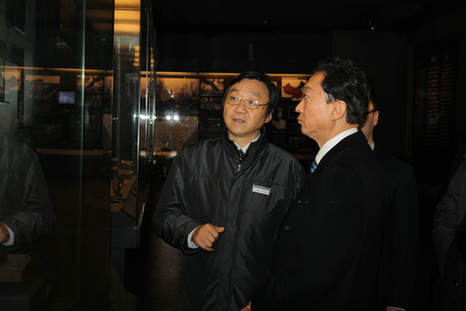Memorialize the Victims of the Nanjing Massacre
Former Japanese Prime Minister Yukio Hatoyama visited the memorial hall on January 17, 2013.

During this time, the curator was striving to set December 13 as China’s National Memorial Day. His proposal was submitted to the state authorities by deputies to the National People’s Congress (NPC) and members of the National Committee of the Chinese People’s Political Consultative Conference (CPPCC). It soon received wide support from the public.
“The survivors are of advanced age. We have lost many of them in the last few years. Only around 100 are still living. To Xia Shuqin, winning the lawsuit has caused more accusations from Japan’s right wingers, which have inflicted further psychological trauma,” Zhu said. “Therefore, setting a National Memorial Day is a great consolation to the survivors and the families of the deceased.”
He also revealed that the massacre was not an isolated case; rather, it was representative of atrocities perpetrated by the Japanese army throughout China. Not only Nanjing but the whole country should mourn the war victims.
China’s top legislature ratified a decision in February 2014 to set December 13 as National Memorial Day for the victims of the Nanjing Massacre. On the first National Memorial Day in December, commemorative activities will be held in Nanjing and are expected to be elevated to a national level for the first time.
“Forgetting history is a challenge to peace,” Zhu said. “To safeguard peace requires us to remember our history. We hope such a massive tragedy will never be repeated in the future and that human beings will live in peace and harmony.” Today, more and more people in China and abroad are learning the historical facts of the Nanjing Massacre.
Memory of the World
Preserving the massacre in the world’s memory is another of Zhu Chengshan’s goals.
In 2009, Zhu, along with 10 other deputies to the Nanjing People’s Congress, proposed that the massacre be added to UNESCO’s Memory of the World Register. In March 2014, the State Archives Administration provided UNESCO with 11 sets of documents relating to the Nanjing Massacre and Japan’s wartime sex slaves, the so-called “comfort women.” According to Zhu, the documents include the diary of Cheng Ruifang, a matron at the Ginling College which was located in the then Nanjing Safety Zone; John G. Magee’s 16mm movie camera and the original film he took of the massacre; 16 photos that record Japanese atrocities, hidden by a local at great personal risk; survey data of the massacre collected by the Chinese government after WWII; archives of the trials of Japanese war criminals by the International Military Tribunal for the Far East and Nanjing War Crimes Tribunal; and documents from Chinese judicial authorities on the investigations, prosecutions and convictions of Japanese war criminals.
Zhu showed that all the documents were recorded in the period between 1937 and 1948. The historical evidence is clear and reliable. Written documents and material objects complement each other, forming a complete chain of evidence. Truthfully recording Japanese crimes against Chinese captives and common people from all angles, the materials have high value for historical studies.
